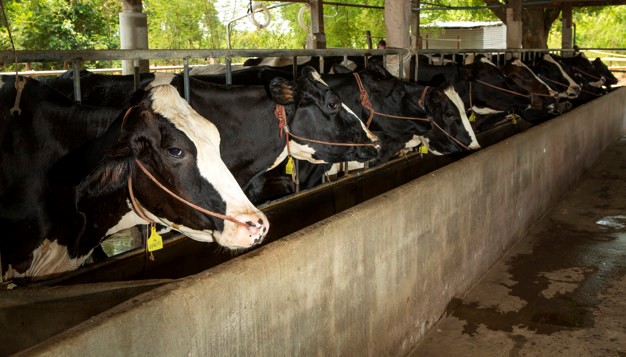

Housing Needs
Cattle housing heavily influences animals’ willingness and ability to display their full heat behavior.
Cubicles
When cows spend ample time standing in cubicles, it causes tiredness and lameness, reducing their estrus demonstration, seriously affecting fertility. While recommendations for cattle cubicle size and design vary according to breed, dairy cattle cubicle floors must always be clean and dry and have a cushioned surface with good grip.
Design Guidelines
- All cows should be able to feed at once – 0.6m/cow (2ft feed space required per cow).
- Cubicle dimensions need to take into account cow type and size. 2.4m x 1.2m (8ft long X 4ft wide) head to head and 2.6m x 1.2m (8ft 6in x 4ft wide) against the wall.
- All cow walkways/scraper passages should be 2.4m (8ft) wide and feeding areas 4.2m (14ft) wide. This will allow free movement of the cows without risk of injury or bullying.
Feeding Space
Fresh, high-quality feed must always be accessible.
Inadequacy of the feeding area reduces feed intake, which has implications for reproduction:
- Diminishes the strength of the signs of estrus
- Compromises hormonal production

Source: Agriculture & Horticulture Development Board. Animal Health and Welfare. Dairy cattle.
Feed face requirements depending on the weight of the animal and the competition for food.

Flooring
Cows feel frightened on slippery floor surfaces, which can prevent them from demonstrating estrus behavior. Flooring for cows must be soft, and manure should be removed from the surface of the walking area several times a day.
Floor slipperiness is one of the most significant risk factors of lameness, a high-pressing health, production and welfare problem on intensive dairy farms. It is a frequent reason for culling, and it is related with reduced fertility. In a recent study, cows that became lame within the first 30 days postpartum were associated with a higher incidence of ovarian cysts, a lower likelihood of pregnancy and lower fertility than control cows1.
Lighting
Light has an essential role in the control of hormone levels in dairy cattle. Uniform lighting in livestock housing improves fertility, and this positively influences estrus and can also reduce the calving interval2.
Height and spacing of the lights affect uniformity of the light. A ratio of 1 is the most appropriate for acquiring a high level of uniformity required in an intense work area. Highly reflective wall, ceiling and floor surfaces will enhance the uniformity of illumination3.
The intensity and duration of the light are important. Research has shown that a lighting regime of 16 hours of light at a minimum of 150 lux, followed by eight hours of darkness (maximum five lux) will produce positive benefits2.
Ventilation Systems in Dairy Barn Design
Ventilation helps maintain a comfortable environment for dairy cattle. Ventilation provides fresh air to:
- Control moisture cows produce through respiration
- Control heat produced by the cows in hot weather
- Remove odors and gases produced by cows from manure, urine and CO2
Natural and Mechanical Ventilation
Passageways and Walkways
Cows need adequate space to walk freely without intimidation by dominant cows and to demonstrate estrus. Cubicle passageways should be between 3 and 4.5 meters wide, which allows space for two cows to pass. Feeding passageways should be 4 to 5 meters wide, to allow for two cows to pass side-by-side behind a feeding cow. With particularly large breeds or types of cow, more space should be allowed.
Management Systems
Recent studies in the UK4 and Ireland5 have shown that the efficiency of estrus detection was significantly higher in cows in pasture-based systems, and the intervals between calving and estrus were longer in cows in zero-grazed systems. Several North American, Dutch and New Zealand studies also support these findings6.
- Melendez, P., Bartolome, J., Archbald, L.F., Donovan, A. 2003. The association between lameness, ovarian cysts and fertility in lactating dairy cows. Theriogenology, 59, 927–937.
- Dawson, J. 2015. Continuous housing of dairy cows – fertility and production. https://www.vettimes.co.uk/.
- Clarke, S., and House, H. 2006. Energy Efficient Dairy Lighting. Infosheet. http:www.omafra.gov.on.ca/English/engineer/facts/06-007.htm.
- Pollott, G.E., Coffey, M.P.. 2008. The effect of genetic merit and production system on dairy cow fertility, measured using progesteroneprofiles and on-farm recording. Journal of Dairy Science 91, 3649–3660.
- Palmer, M.A., Olmos, G., Boyle, L.A., Mee, J.F. 2012. A comparison of the estrous behaviour of Holstein-Friesian cows when cubicle-housed and at pasture. Theriogenology 77, 382–388.
- Mee, J.F. 2012. Reproductive Issues Arising from Different Management Systems in the Dairy Industry. Reproduction in Domestic Animals 47 (Suppl. 5), 42–50.

